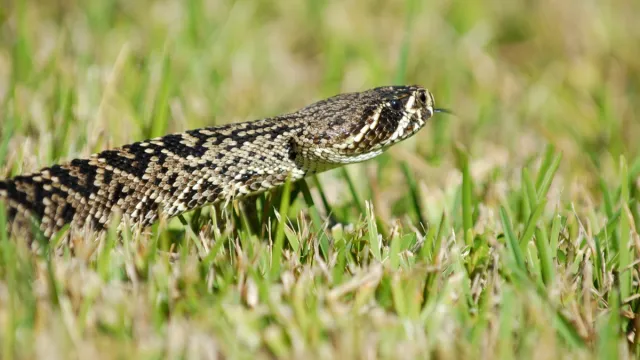If You Live in These States, Watch Out for This Highly Venomous Snake

You can come across snakes of all different types and sizes throughout the U.S., as there are around 50 snake species present in the country, per the Morgridge Institute for Research. Several snakes here are so harmless and friendly that they’re even kept as pets, like king snakes, rat snakes, garter snakes, and corn snakes. But in some states, you have to watch out for highly venomous snakes, including the dreaded eastern diamondback rattlesnake.
RELATED: If You Live Here, Prepare for an Influx of Snakes.
The eastern diamondback rattlesnake is the largest rattlesnake species, which also makes it the largest venomous snake in the U.S., according to National Geographic. Some eastern diamondback rattlesnakes can weigh up to 10 pounds and grow as big as eight feet in length, while also having the ability to live 10 to 20 years.
This snake has an easily recognizable yellow-bordered, light-centered black diamond skin pattern, and it feeds on squirrels, birds, and household pests like rats and mice—which means it may try searching for its food near your home. Thankfully, the eastern diamondback rattlesnake only attacks in defense, and “most bites occur when humans taunt or try to capture or kill a rattlesnake,” National Geographic notes. Still, you definitely don’t want to try your luck if you come across one, because it can accurately strike you at up to one-third of its body length.
RELATED: For more up-to-date information, sign up for our daily newsletter.
According to the Smithsonian’s National Zoo and Conservation Biology Institute, a venomous bite from the eastern diamondback rattlesnake can be fatal to humans because of a toxin in their venom. Hemotoxin kills red blood cells and causes tissue damage in humans, and it only takes seconds for venom to enter your bloodstream once bitten, Healthline reports.
Fortunately, anti-venom, a medicine given to stop venom’s serious effects, is usually available in the states where these snakes are found—so death from rattlesnake bites are rare, per the Smithsonian Institute. According to the Centers for Disease Control and Prevention (CDC), around 7,000 to 8,000 people are bitten by venomous snakes in the U.S. each year, though only about five die.
But it’s important to know if your state is one where the eastern diamondback is lurking, so you can be prepared to seek emergency medical care immediately in the event of a bite. “The number of deaths would be much higher if people did not seek medical care,” the CDC warns. And according to Healthline, just two days of an untreated rattlesnake bite can result in severe organ damage or death. The U.S. Fish & Wildlife Service says the eastern diamondback rattlesnake has been located in seven different U.S. states. Read on to find out which state residents should be on the lookout.
RELATED: Leaving This in Your Garage Is Bringing Snakes to Your Home, Experts Warn.
1
Alabama

2
Florida

3
Georgia

4
Louisiana

5
Mississippi

6
North Carolina

7
South Carolina

RELATED: If You See This Rare Venomous Spider, Keep Your Distance.